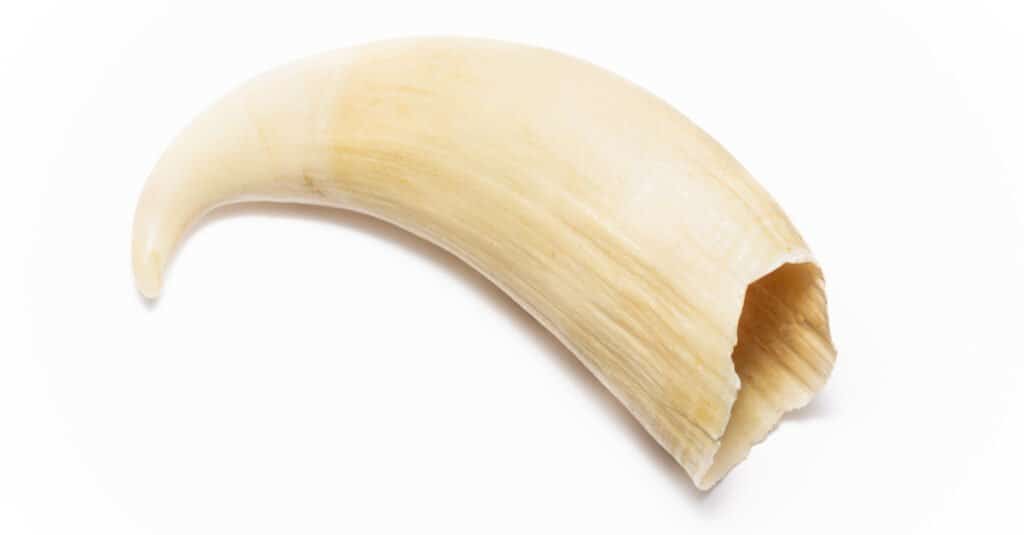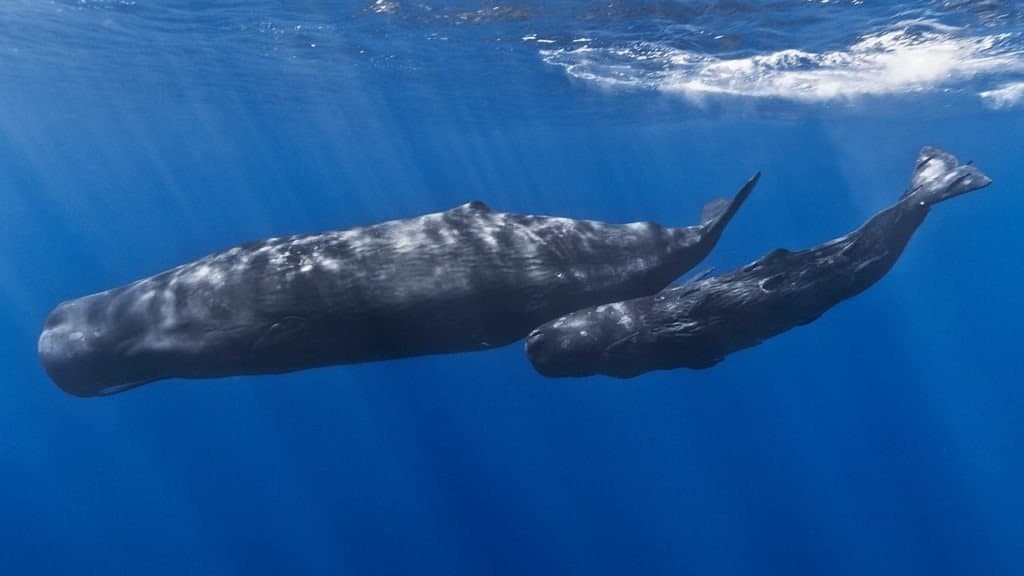
Sperm whales are the largest toothed predator on Earth.
©bekirevren/Shutterstock.com
Sperm whales are the largest toothed predator in the world, and the largest toothed whale. They’re members of the Cetacea order, which is further subdivided into baleen whales like humpbacks, and toothed whales like sperm whales and dolphins. Toothed whales are special because, unlike baleen whales–who use their mouths to filter feed tiny critters, toothed whales hunt their prey.
But just what do sperm whales hunt, and how do they use their teeth to feed? Here, we’ll discover more about these fascinating teeth, what they use them for, how scientists use them for aging and DNA studies, and the unique art form created specially for these incredible teeth.
What’s So Special About Sperm Whale Teeth?

Sperm whales have up to 60 conical teeth in their bottom jaw
©Steven Giles/Shutterstock.com
Sperm whales are odontocetes, meaning toothed whales. Unlike humans–who have four types of teeth (incisors, canines, premolars, and molars), sperm whales are monophyodonts, which means they only have one type of tooth.
This single tooth is banana shaped, with a slight curve towards the sperm whale’s body. It can reach up to eight inches in length and weigh over two pounds. Sperm whales have between 36-60 teeth–all located on their bottom jaw (mandible). Sperm whales very rarely have teeth in their upper jaw. Instead, their upper jaw is full of sockets that the teeth on the bottom fit into.
Peculiar Mandibles
Sperm whales are famous for their big heads. A sperm whale’s head can reach nearly twenty feet in length, and their mandible is nearly as long. But what’s so special about the sperm whale’s lower jaw?
Well, the mandible of the sperm whale has evolved so that, instead of each row of teeth being separated by a tongue–the rows are actually right next to each other. The sperm whale’s tongue is actually short and fat, and sits far back in its mouth. The two sides of the lower jaw are fused together for most of their length, which gives the sperm whale’s mandible its distinctive rod-like shape.
What Do Sperm Whales Use Their Teeth For?
Sperm whales have large, fearsome teeth. But with such a strange jaw, and only bottom teeth, just what do they use them for?
Because sperm whales spend so much of their lives diving to great depths for food, it’s difficult for scientists to observe their behavior directly. By looking at things like stomach contents and feces, they can approximate pretty closely what these giants eat, and how they use their teeth to catch their prey.
Sperm whales mostly eat squid (including giant squid). But, because healthy sperm whales have been found with broken jaws or teeth that have completely worn away, scientists believe their teeth play little role in feeding. Rather, it is believed that sperm whales simply suck squid into their mouths. They use their powerful tongues to guide the prey down their throat.
Fighting Teeth
So, if sperm whales don’t use those big teeth for eating, what do they use them for?
Based on studies of rake mark scars on adult sperm whales, scientists think these giants of the deep use their jaws aggressively–against each other. Rake marks are particularly prevalent on large bull sperm whales, those that would compete with each other. Though, whether the sperm whales are competing for territory, mates, or dominance, is unknown. One thing’s for sure though; sperm whales prefer to suck their food down, and save their teeth for each other.
Using Teeth to Tell Age

Sperm whales only have one set of permanent teeth that lasts them their whole life
©Gabriel Barathieu / CC BY-SA 2.0 – License
Sperm whales spend a long time growing up; calves stay with their mother for over ten years. Despite this long youth, sperm whales are monophyodonts–meaning they have no milk teeth, only one set of permanent teeth that they keep for their entire lives.
As they grow, their teeth grow larger, layer by layer. A the teeth are made up of dentin at the root, with hard cementum covering the dentin below the gumline. Above the gumline, the dentin is covered by enamel. A sperm whale’s enamel is extremely hard, and builds up in layers.
Much like reading tree rings, scientists can examine these layers to tell the approximate age of the sperm whale. The more layers–the older the whale.
Extracting DNA from Teeth
Scientists can learn more from sperm whales’ teeth than just their age. Using new methods of DNA extraction and analysis, scientists can actually trace mitochondrial family trees in sperm whales. This is especially important today, since sperm whale populations are severely decreased from what they once were.
Because sperm whales used to be heavily hunted, their teeth (which are a type of ivory) were often collected. Today, these teeth are housed in museum and private collections around the world. All of these specimens present scientists with a smorgasbord of testable material. These historic teeth, once tested, will allow scientists to build a complete background on the historical genetic diversity of sperm whales.
DNA extraction may seem like a strange use for teeth. But, sperm whale teeth have long been used for an even more interesting purpose.
Scrimshaw: Carved Teeth
Scrimshaw is the technique of painting or carving scenes on ivory, particularly on sperm whale teeth. It was first developed by the Inuit people of the Northern Hemisphere. The practice was later co-opted by sailors aboard whaling ships, who had plenty of teeth to work with.
The finished pieces of art became widely popular in the 19th and 20th centuries, and were often featured in private collections. Today, it is illegal to import or sell whale ivory–including teeth–unless you have a special permit. This is due to the trade in illegal ivory, and the ensuing poaching of endangered animals, like sperm whales, that the trade causes.
No matter the use–whether as art, weapons against other sperm whales, or as tools for learning more about this mysterious species–people are fascinated by sperm whales and their unique teeth.
The photo featured at the top of this post is © Martin Prochazkacz/Shutterstock.com
Thank you for reading! Have some feedback for us? Contact the AZ Animals editorial team.






